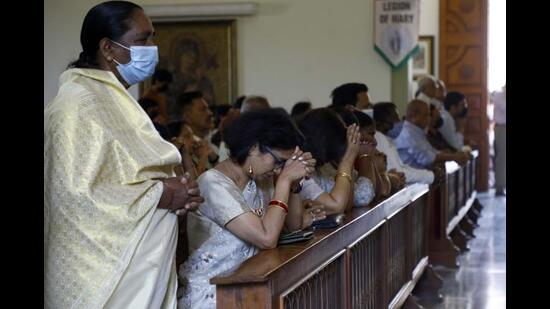Jesus Christ: Superstar or Superman?
I am not a believer, but long ago as a young woman I had somehow felt connected with Jesus. Not the Bible, not the priests and nuns, not the sermons, just the person. The mystique inspired curiosity.
What is it about religious icons that makes us want to relate to them as real people even as we know that the world deifies them? How does it, then, make us different from a pop version of Herod who baits Christ to “walk across my swimming pool”? Would a human ‘divinity’ by its very accessibility cease to rise above such triviality?
What about the Mary Magdalenes waiting in the wings, the Judases who, despite their treachery or perhaps because of it, become heroic enough for taking on the messiahs, or even the Christ who cries out, “My God, my God, why have you forsaken me”?
This brings me to the person of Christ and the questions it raises.
In a brilliant book Jesus The Man: New Interpretations from the Dead Sea Scrolls by biblical scholar and theologian Barbara Thiering, one gets to discover that “the divinity (of Jesus may have) to be sacrificed to the humanity”. But she also iterates that it does not mean that “because an illusory ideal of a perfect human life fails, the Church has no more resources for moral teaching”.
It sounds radical but Jesus could have been the leader of a faction of Essene priests, was not of virgin birth, did not die on the Cross. This may seem blasphemous, but Thiering manages to make Christ come alive. A reader could also perceive him as a Sufi, rising above his fallibilities for, as the New Testament has said about him, “Because he himself has suffered and been tempted, he is able to help those who are tempted.”
Mary Magdalene was not the culprit. History has sidelined her for obvious reasons, but to see her in an almost feministic light is an enlightenment. According to the Gospel of Philip, “And the companion of the (Saviour was) Mary Magdalene. He loved her more than all the disciples…The rest of the disciples (were offended and) said to him, ‘Why do you love her more than all of us?’ The Saviour answered, ‘Why do I not love you like her? When a blind man and one who sees are both together in darkness, they are no different from one another. When the light comes, then he who sees will see the light and he who is blind will remain in darkness’.”

Mary — or Miriam — was not a name but a title of prophetess given to a woman in the Ministry. This is no trifling matter. She may have been referred to as one “from whom seven demons had gone out”, yet certain researchers were convinced that Jesus held her in such high esteem that after a three-year trial marriage as per the prevalent custom, he did wed Mary Magdalene when Jonathan was Pope. It was believed that he was “affirming his right to continue the dynasty”. A daughter and two sons are said to have been born.
Although a “fallen woman” theory has been perpetuated for long, certain facts can be seen in a different light because they give a refreshing view about the character of Jesus. If we go by the premises set forth by Thiering, he comes across as a radical, liberal person.
Mary Magdalene, who was not young at 27 when she was with Jesus, could have had an earlier marriage. She also had definite political views. “Mary was a zealot with opposite views of those of Jesus”, she belonged to an Ecstatic order, the Eastern Nationalist Party, whose believers were called “seekers-after-smooth-things”. Such was her commitment to her cause that she chose to separate from Jesus. This might come as a surprise, if not travesty, but even if divorce was not permitted between a Christian couple, if one partner was a non-believer — as Mary was — the matter was deemed personal. In fact, it is implied that Jesus had a second marriage too, and to Lydia “the Lord opened the heart”.
These views may sound controversial and one scholarly reviewer had dismissed Thiering as an “embarrassing eccentric” whose book is “a quite extraordinary feat of disciplined creative imagination”. She was aware she was treading on holy territory: “If the reading of it is a serious difficulty now, it is because the person of Jesus has been allowed to lose all humanity, contrary to the Church’s own desire to teach full humanity with divinity. It has rarely achieved such a balance for the natural reason that it is almost impossible to hold both concepts together.”
This probably explains why even Judas went against him. Judas has got the great lines, he is the brash upstart trying to show the Lord’s feet of clay. Besides the theological reason that he was “bitterly antagonistic to Jesus for his claim to the high priesthood and his opposition to ritual law”, there are psychological aspects too. He was jealous of the fame of a man who appeared so deceptively simple. He was possessive and could not accept Mary Magdalene’s role. His obsession was dangerous because it bordered on the manic (as opposed to Christ’s depressive). He did not drink, was not known to womanise; for him, Jesus was a friend and hero and he wanted to be kingmaker, but his self-esteem wanted him to rebel. The “thirty pieces of silver” were not to betray, but to seek out his own identity. It is for this reason that his crucifixion was even more tragic; he was his own victim.
Jesus was far more polished and, in some ways, sharper. When he realised that there was a horde opposing him, he himself started making preparations for the Last Supper. It is suggested that while he initially refused poison on the Cross to lessen his pain, later Christian sources claim that he relented and took the “vinegar”, wine spoiled by poison. It was only then that he “gave up the spirit”.

The characterisation of Christ has always been complicated by various streams of thought, including questions about his race. These only serve to make him more fascinating. “Jesus, and those close to him, were frail human beings, as we all are, caught in personal dilemmas which could be solved only in terms of the particular situation, not by conformity to ideal rules.”
That is how messiahs start out. Unfortunately, with time a halo appears to distance them. Which is perhaps why devotees sustain the ethereal image. As a healer, he must have tapped the wellsprings of his humanity; as a miracle-maker he would have trained in exercises of self-control; and as a prophet he probably was a lesson in humility.
The portrayal of Jesus Christ as a vulnerable prophet who looks tired, frustrated and angry makes him appear even more humanly divine.
Farzana Versey is a Mumbai-based writer. She tweets at @farzana_versey
This winter season, get Flat 20% Off on Annual Subscription Plans
Enjoy Unlimited Digital Access with HT Premium

I am not a believer, but long ago as a young woman I had somehow felt connected with Jesus. Not the Bible, not the priests and nuns, not the sermons, just the person. The mystique inspired curiosity.
What is it about religious icons that makes us want to relate to them as real people even as we know that the world deifies them? How does it, then, make us different from a pop version of Herod who baits Christ to “walk across my swimming pool”? Would a human ‘divinity’ by its very accessibility cease to rise above such triviality?
What about the Mary Magdalenes waiting in the wings, the Judases who, despite their treachery or perhaps because of it, become heroic enough for taking on the messiahs, or even the Christ who cries out, “My God, my God, why have you forsaken me”?
This brings me to the person of Christ and the questions it raises.

In a brilliant book Jesus The Man: New Interpretations from the Dead Sea Scrolls by biblical scholar and theologian Barbara Thiering, one gets to discover that “the divinity (of Jesus may have) to be sacrificed to the humanity”. But she also iterates that it does not mean that “because an illusory ideal of a perfect human life fails, the Church has no more resources for moral teaching”.
It sounds radical but Jesus could have been the leader of a faction of Essene priests, was not of virgin birth, did not die on the Cross. This may seem blasphemous, but Thiering manages to make Christ come alive. A reader could also perceive him as a Sufi, rising above his fallibilities for, as the New Testament has said about him, “Because he himself has suffered and been tempted, he is able to help those who are tempted.”
Mary Magdalene was not the culprit. History has sidelined her for obvious reasons, but to see her in an almost feministic light is an enlightenment. According to the Gospel of Philip, “And the companion of the (Saviour was) Mary Magdalene. He loved her more than all the disciples…The rest of the disciples (were offended and) said to him, ‘Why do you love her more than all of us?’ The Saviour answered, ‘Why do I not love you like her? When a blind man and one who sees are both together in darkness, they are no different from one another. When the light comes, then he who sees will see the light and he who is blind will remain in darkness’.”

Mary — or Miriam — was not a name but a title of prophetess given to a woman in the Ministry. This is no trifling matter. She may have been referred to as one “from whom seven demons had gone out”, yet certain researchers were convinced that Jesus held her in such high esteem that after a three-year trial marriage as per the prevalent custom, he did wed Mary Magdalene when Jonathan was Pope. It was believed that he was “affirming his right to continue the dynasty”. A daughter and two sons are said to have been born.
Although a “fallen woman” theory has been perpetuated for long, certain facts can be seen in a different light because they give a refreshing view about the character of Jesus. If we go by the premises set forth by Thiering, he comes across as a radical, liberal person.
Mary Magdalene, who was not young at 27 when she was with Jesus, could have had an earlier marriage. She also had definite political views. “Mary was a zealot with opposite views of those of Jesus”, she belonged to an Ecstatic order, the Eastern Nationalist Party, whose believers were called “seekers-after-smooth-things”. Such was her commitment to her cause that she chose to separate from Jesus. This might come as a surprise, if not travesty, but even if divorce was not permitted between a Christian couple, if one partner was a non-believer — as Mary was — the matter was deemed personal. In fact, it is implied that Jesus had a second marriage too, and to Lydia “the Lord opened the heart”.
These views may sound controversial and one scholarly reviewer had dismissed Thiering as an “embarrassing eccentric” whose book is “a quite extraordinary feat of disciplined creative imagination”. She was aware she was treading on holy territory: “If the reading of it is a serious difficulty now, it is because the person of Jesus has been allowed to lose all humanity, contrary to the Church’s own desire to teach full humanity with divinity. It has rarely achieved such a balance for the natural reason that it is almost impossible to hold both concepts together.”
This probably explains why even Judas went against him. Judas has got the great lines, he is the brash upstart trying to show the Lord’s feet of clay. Besides the theological reason that he was “bitterly antagonistic to Jesus for his claim to the high priesthood and his opposition to ritual law”, there are psychological aspects too. He was jealous of the fame of a man who appeared so deceptively simple. He was possessive and could not accept Mary Magdalene’s role. His obsession was dangerous because it bordered on the manic (as opposed to Christ’s depressive). He did not drink, was not known to womanise; for him, Jesus was a friend and hero and he wanted to be kingmaker, but his self-esteem wanted him to rebel. The “thirty pieces of silver” were not to betray, but to seek out his own identity. It is for this reason that his crucifixion was even more tragic; he was his own victim.
Jesus was far more polished and, in some ways, sharper. When he realised that there was a horde opposing him, he himself started making preparations for the Last Supper. It is suggested that while he initially refused poison on the Cross to lessen his pain, later Christian sources claim that he relented and took the “vinegar”, wine spoiled by poison. It was only then that he “gave up the spirit”.

The characterisation of Christ has always been complicated by various streams of thought, including questions about his race. These only serve to make him more fascinating. “Jesus, and those close to him, were frail human beings, as we all are, caught in personal dilemmas which could be solved only in terms of the particular situation, not by conformity to ideal rules.”
That is how messiahs start out. Unfortunately, with time a halo appears to distance them. Which is perhaps why devotees sustain the ethereal image. As a healer, he must have tapped the wellsprings of his humanity; as a miracle-maker he would have trained in exercises of self-control; and as a prophet he probably was a lesson in humility.
The portrayal of Jesus Christ as a vulnerable prophet who looks tired, frustrated and angry makes him appear even more humanly divine.
Farzana Versey is a Mumbai-based writer. She tweets at @farzana_versey
This winter season, get Flat 20% Off on Annual Subscription Plans
Enjoy Unlimited Digital Access with HT Premium

